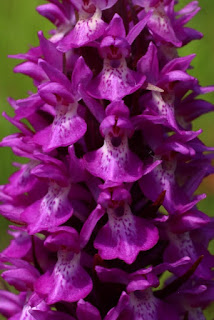Wednesday last week brought the fortnightly BSBI Workout (or Atlas 2020 Recording). Sue had arranged permission for us to go over farmland between Enstone and Chieveley, 12 minutes drive from Hooky. It turned out to be surprisingly varied and we notched up around 215 species (one every 75 seconds), with a riverbank, woodland edge, a real find, a species-rich limestone embankment, and at the end of the meander, a former, now overgrown, quarry.
 |
| Weld |
 |
| Field Pansy on the Edge of a Field of Oilseed Rape |
 |
| Rough Comfrey (provisional - sent to referee) |
I am by far the least able regarding botanical competence, and the party humours me by asking for my thoughts whenever an orchid in leaf is found, because I do have some experience with that family.(In fact we found two plants, which were probably Bee orchids (Ophrys apifera). In passing, Sarah said she had found a large group of orchids on an embankment alongside the Newbury Bypass - the A34, which connects the M40 to the south coast, - but was not sure what they were and if I was passing the site she would appreciate a second opinion.
An invitation not to be missed, we went botanising on the A34 today, parking in a layby just beyond the orchids, ignoring the Wide Loads Only sign (and thereafter waiting for the police to show up to reprimand us or worse). There must have been over 300 orchids on what anywhere else would be revered as species rich, unimproved, limestone grassland.
 |
Newbury Bypass
|
The most striking thing was the orchid colour, a deep, purplish magenta, deeper than the hue of most Southern Marsh Orchids (Dactylorhiza praetermissa) I have seen, but to which I attributed most of the plants based on the labellum shape, unspotted leaves and so on. Some plants though were hybrids known as D. x grandis with Common Spotted Orchids (D. fuchsii); this parent was only just coming in to flower. The hybrid is fertile and can back cross with the parents, so some plants had mostly the characteristics of D.praetermissa but there was clearly introgression. In fact the whole population might be a little introgressed, given the deep colour, robust plants and the fact that they were flowering early.
 |
| D.praetermissa |
 |
| D.praetermissa |
 |
| D. x grandis |
 |
| D. x grandis |
 |
| D. fuchsii |
Fortunately no one stopped to enquire as to what we were doing; whilst I busied, photographing just about every plant, she did a survey of motorists and passengers on mobile phones to pass the time. Maybe she will write her own blog.
At home I had the moth trap out on Friday night, with a catch of 16 moths, representing by 9 species together with 4 cockchafer beetles.
 |
| Pale Tussock |
 |
| Cockchafer |











No comments:
Post a Comment